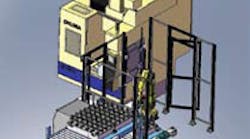Edited By Charles Bates | Senior Editor
Eight years ago, RFM, a unit of Mitsubishi Materials USA, transitioned from a special-order job shop to a high-volume manufacturer of indexable, multi-pocketed milling cutters, end mills and drills. Since then, the Brighton, Mich., shop has quadrupled its annual sales and increased production output 25 percent by judiciously applying automation to its machining processes.
Even after expanding its facility, upgrading its CNC machines and adding a second shift, RFM was hard-pressed to keep up with increasing demand for its products. Rather than increase facility size or simply add more equipment, RFM vice president and general manager Rudy Meffert and his team realized they had to “do more with less.”
RFM contacted Gosiger Michigan, the local Okuma distributor, for its input on cost-effectively automating operations. What Gosiger Automation came up with was a high-volume cell that could run continuously, including operating unattended overnight and during weekend hours.
The automated cell produces more parts than three manually loaded machines combined. It consists of an Okuma MB46VA vertical machining center equipped with a Tsudakoma TN-200 fourth and fifth-axis tilting rotary table and a six-axis Fanuc M16iB robot. To optimize servicing the cell, the robot loads through a side door, leaving the front of the machining center and control panel unobstructed.
A key to the system’s efficiency involves mounting rough tool blanks into CAT 50 tool holder bodies held by the rotary table. This means that a robot equipped with a single set of grippers designed for CAT 50 tool holders can handle virtually any part processed by the machine tool.
Machine operators mount the rough part blanks in the toolholder bodies, and these, in turn, are loaded into special pallets. Each pallet, which holds 25 tool blanks, is automatically conveyed to the robot that will load the blanks into the machining center. After completing the machining cycle, the system returns the part to the pallet. When full, the pallets are automatically discharged from the cell. The system is capable of running these pallets through the process continuously.
To maximize the cell’s efficiency, RFM refined its traditional set-up procedures, in part, by standardizing the tools list used for each part run, and by documenting tool life. According to Meffert, the shop found that each operator had a favorite cutting tool assembly for an operation, leading the shop to analyze the process and use its findings to designate the best tool assemblies for that job.
“Now we can better manage tool usage and have the right back-up tools available for long runs. As a result, we have more predictable, consistent tool performance that helps keep the machining center running continuously,” said Meffert.
RFM intends to continue its automation endeavor and plans to have Gosiger install a track for the current robot, so it can service three machining centers to triple efficiency with minimal additional investment.








